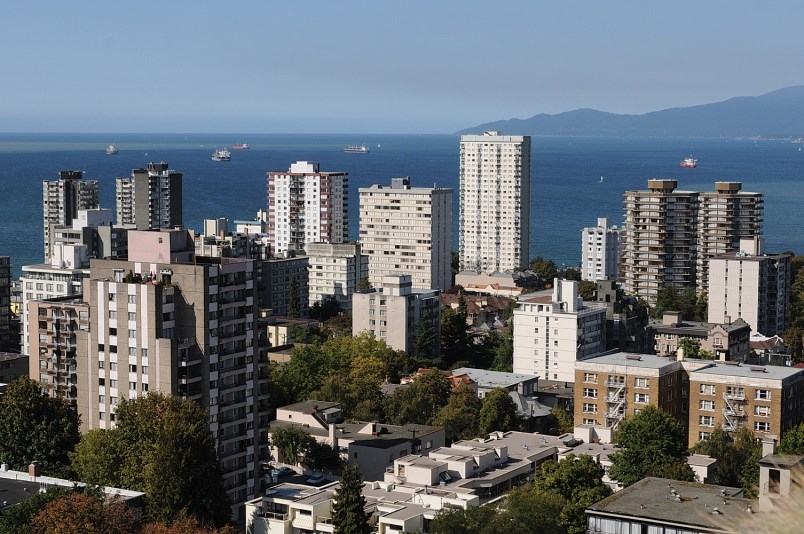Technically achievable but pushes the limits.
That’s how the city’s climate policy manager has framed the ambitious push to drop Vancouver’s carbon emissions by 1.2 million tonnes by the year 2030.
“We’re trying to be very clear that this is pushing the limits of what we think we can achieve, and we know they’ll push the limits of our partners in the community,” Matt Horne told reporters in a briefing April 18 at city hall.
In other words, residents, businesses, governments and various agencies all have to be on board for Vancouver to reduce carbon pollution over the next 11 years.
The challenge of that work is evident: the city needs to drop an average of 92,000 tonnes per year over the next decade, which is a five-fold increase from the previous decade.
To get there, Horne and the city’s climate change department have developed a set of “six big moves” and 53 “accelerated actions” that will go before city council Wednesday.
The 53-page staff report sets out a future that includes a subway along the Broadway corridor, zero emission zones for vehicles and increasing the number of trees in Vancouver.
Other measures include more mass timber construction, large scale restoration of shorelines and designing neighbourhoods where people have access to their daily needs such as schools, transit and grocery stores.
If council agrees to the recommendations, the “move” with the biggest impact will be to ensure space and water heating systems installed in new buildings and those replaced in existing buildings are zero emission.
Such a move would reduce Vancouver’s carbon pollution by 552,000 tonnes per year by 2030, which equates to 46 per cent of the city’s goal to reach 1.2 million tonnes.
Heat pumps are expected to be an important solution to achieve that goal, according to the city report. The pumps are more than 200 per cent efficient at capturing heat from the air, ground or waste sources.
“They also cool buildings, which will be especially important as climate change causes hotter summers,” the report said.
The five other “big moves” are:
- A walkable city.Create more “complete neighbourhoods” where people can walk or roll (in a wheelchair, scooter or on a bike) to jobs, schools, parks and transit from their homes.
For context, approximately 45 per cent of residents live within an easy walk or roll of their daily needs. Increasing that percentage to 90 per cent will require “sensitively introducing more housing choices and essential amenities” to neighbourhoods, the report said.
Meeting the 90 per cent target would mean 153,000 tonnes per year of carbon pollution reduced by 2030. That’s 13 per cent of the city’s overall target of 1.2 million tonnes.
- Safe and convenient active transportation and transit.By 2030, have two-thirds of trips in Vancouver made by walking, biking or transit. That goal rolls back the target by 10 years, as first envisioned in the city’s Transportation 2040 plan.
The report said success will require “a significantly improved transit capacity and efficiency, better connected active transportation networks city-wide and continued expansion of high-quality reliable transit across the city and region.”
Horne said completing the Broadway subway would be a big boost to achieving the city’s goal of reducing 141,000 tonnes per year of carbon pollution by 2030. That’s 12 per cent of the city’s overall target of 1.2 million tonnes.
- Pollution-free cars, trucks and buses.Have 50 per cent of the kilometres driven on Vancouver’s roads to be done in electric vehicles by 2030.
To achieve such a transition, the city says it will need to add more residential, commercial and public charging infrastructure. It will have to implement parking policies that encourage and eventually require zero emission vehicles.
Horne said statistics show 15 per cent of car sales in B.C. last year were for electric vehicles.
“So the dial is starting to move in that market,” he said.
Implementing zero emission zones that discourage and eventually ban polluting vehicles from specific areas or corridors is another likely measure, said Horne, noting London recently launched zero emission zones.
A rapid transition to electric and other zero emission vehicles would reduce Vancouver’s carbon pollution by 283,000 tonnes per year by 2030 (24 per cent of the targeted reductions), the report said.
- Lower carbon construction materials and designs.The objective is to reduce emissions generated from suppliers of construction materials by 40 per cent. That would mean 78,000 tonnes per year of carbon could be reduced by 2030.
Such a move would mean a shift in construction practices, including the use of more mass timber and low carbon concrete and rely more on prefabricated and modular construction.
Eliminating spray foam insulation “with high-carbon blowing agents” and using more recycled aggregate and asphalt are other recommendations.
“The city will need to work with regional, provincial, national and international partners to improve standards and protocols for embodied emissions accounting in order for this work to be successful,” the report said.
- Restored forests and coasts.That includes large scale restoration of shorelines and subtidal zones along False Creek, the Fraser River, English Bay, Burrard Inlet and Trout Lake.
For this “move,” Horne noted reductions in emissions would be minimal in 2030 because ecosystems take time to recover and grow once any planting is complete.
If council approves the recommendations in the report, Horne said staff will return with cost estimates and outline specifically how each of the big moves would be achieved.
Coun. Christine Boyle, who pushed in January for the city to set more ambitious targets to fight climate change, took to Twitter to show her support for the new direction recommended by staff.
“I’m part of a new generation of politicians who are going to have to live with the consequences of climate change for the rest of our lives, and we’re no longer prepared to keep kicking the can down the road,” Boyle wrote. “Climate change is real, and urgent. It’s time to govern as if we understand that.”
@Howellings



